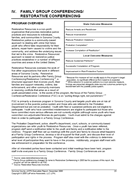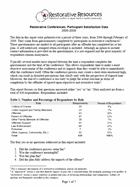
"The plan the young offender had to follow was far more thorough than any probation of jail time he would have received. Nice work."
--Law Enforcement Officer
"What was most meaningful was getting to tell my story and my experience to the young offender directly. I felt involved in a healing process rather than a process that was merely punitive."
--Crime Victim
"All the hate was gone after we talked."
--Juvenile Offender
Restorative Justice brings victims of crime and their offenders, along with affected family and community members, together in a restorative conference that builds understanding, explores impacts, and develops agreements for
what will be done to make things right. The result: truly meaningful justice for all involved; justice that heals.
Rather than focussing on punishing the guilty party, restorative justice emphasizes repairing the harm caused by criminal behavior. It is best accomplished through cooperative processes that include all stakeholders.
Restorative processes respond to crime by:
- Identifying and taking steps to repair harm,
- Involving all stakeholders, and
- Transforming the traditional relationship between communities and their governments in responding to crime.
Restorative justice is founded on principles including:
- Justice requires that we work with those who have been injured to help restore a sense of well-being, safety, and community.
- Those most directly involved and affected by crime should have the opportunity to participate fully in the response to the crime.
- Those who have harmed others have incurred obligations to make things right, or as right as possible.
- The community benefits by participating in restorative actions.
Restorative programs are characterized by four key values:
- Encounter: Create opportunities for victims, offenders and community members to meet to discuss the crime and its aftermath.
- Amends: Expect offenders to take steps to repair, to the extent possible, the harm they have caused.
- Reintegration: Seek to restore victims and offenders to whole members of society who contribute in positive ways.
- Inclusion: Provide opportunities for parties with a stake in a specific crime to participate in its resolution. This includes victims, offenders, their family members, law enforcement and other community members.
Independent Evaluator's Findings 2005 (click image to view full report) |
|---|

|
| Participant Satisfaction Survey Data, 2006-2008 (click image to view report) |

|
|